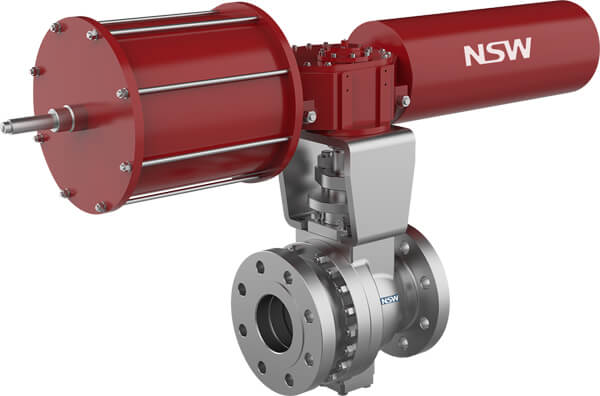In industrial processes, safety and operational efficiency are paramount. One critical component that ensures both is the shut down valve (SDV). This article explores how a shut down valve works, its key components, advantages, and applications. We’ll also highlight NSW, a leading shut down valve manufacturer known for engineering reliable and high-performance valves for demanding industries.
—
What Is a Shut Down Valve
A shut down valve (SDV) is an automated safety device designed to isolate fluid flow in a pipeline or system during emergencies or abnormal conditions. It acts as a “last line of defense” to prevent accidents, equipment damage, or environmental harm by swiftly stopping the flow of liquids, gases, or hazardous chemicals.
SDVs are widely used in oil and gas, chemical plants, power generation, and other industries where rapid response to leaks, overpressure, or system failures is critical. Their ability to operate autonomously—triggered by sensors or control systems—makes them indispensable for modern industrial safety protocols.

—
How Does a Shut Down Valve Work
Shut down valves operate on a simple yet effective principle: **detect, activate, and isolate**. Here’s a step-by-step breakdown of their working mechanism:
1. Detection of Abnormal Conditions
– SDVs are integrated with sensors or linked to a control system (e.g., SCADA, DCS) that monitors parameters like pressure, temperature, flow rate, or gas leaks.
– When a predefined threshold is exceeded (e.g., a pressure spike or toxic gas detection), the system sends a signal to the valve.
2. Activation of the Valve
– Upon receiving the signal, the valve’s actuator (pneumatic, hydraulic, or electric) initiates immediate closure.
- The actuator converts energy (air, fluid, or electricity) into mechanical motion to move the valve’s closure element (e.g., ball, gate, or butterfly).
3. Isolation of the Flow
– The closure element seals the pipeline, stopping fluid flow within seconds.
- Once the system stabilizes, the valve can be manually or automatically reset to resume normal operations.
Key Takeaway: Shut down valves prioritize speed and reliability. Their fail-safe design ensures they close even during power outages or control system failures.
—
Main Components of a Shut Down Valve
Understanding the anatomy of an SDV helps clarify its functionality:
1. Valve Body
– Constructed from durable materials like stainless steel or carbon steel to withstand high pressures and corrosive media.
– Available in designs such as ball valves, gate valves, or butterfly valves, depending on the application.
2. Actuator
– The “muscle” of the SDV, responsible for rapid valve movement.
– Pneumatic actuators use compressed air, hydraulic actuators rely on fluid pressure, and electric actuators operate via motors.
3. Control System Interface
– Connects the valve to sensors, PLCs, or emergency shutdown (ESD) systems for real-time monitoring and activation.
4. Positioner and Limit Switches
– Ensure precise valve positioning and provide feedback on open/closed status.
5. Manual Override
– Allows operators to manually close or open the valve during maintenance or system testing.
NSW Shut Down Valves: As a trusted shut down valve manufacturer, NSW integrates advanced materials and failsafe actuators to deliver valves with <1-second response times, ensuring maximum protection in critical scenarios.
—
Advantages of Using Shut Down Valves
SDVs offer several benefits that enhance safety and operational reliability:
1. Rapid Emergency Response
– SDVs close within seconds, minimizing the risk of spills, explosions, or environmental contamination.
2. Automated Operation
- Reduces human error by eliminating reliance on manual intervention during crises.
3. Durability in Harsh Environments
– High-quality materials and coatings (e.g., epoxy, Inconel) ensure longevity in extreme temperatures or corrosive settings.
4. Compliance with Safety Standards
– SDVs meet international standards like API 6D, ISO 10434, and SIL 2/3 certifications, essential for industries like oil and gas.
5. Minimal Maintenance
– Robust design and self-diagnostic features reduce downtime and lifecycle costs.
Case Study: A refinery using NSW shut down valves reported a 40% reduction in unplanned shutdowns due to the valves’ reliability in isolating leaks during pressure surges.
—
Applications of Shut Down Valves
SDVs are essential in industries where safety and precision are non-negotiable:
1. Oil and Gas
– Protects pipelines and processing units from overpressure, leaks, or fire hazards.
2. Chemical Processing
– Prevents accidental release of toxic or flammable chemicals.
3. Power Generation
– Safeguards boilers and steam systems from catastrophic failures.
4. Pharmaceuticals
– Ensures sterile processes by isolating contaminants during production.
5. Water Treatment
– Controls flow in high-pressure pumping systems to avoid equipment damage.
Why Choose NSW? As a top shut down valve manufacturer, NSW customizes valves for specific media, pressures, and temperatures. Their valves are tested for 100,000+ cycles, ensuring performance in the most challenging environments.
—
Conclusion
Shut down valves are indispensable for modern industrial safety, combining rapid response, automation, and robust engineering. By understanding their working principles, components, and applications, industries can make informed decisions to protect their assets and personnel.
For businesses seeking reliable SDVs, partnering with a reputable shut down valve manufacturer like NSW ensures access to cutting-edge technology and compliance with global safety standards. Explore NSW’s range of valves to enhance your facility’s safety and efficiency today.
Post time: Apr-27-2025






